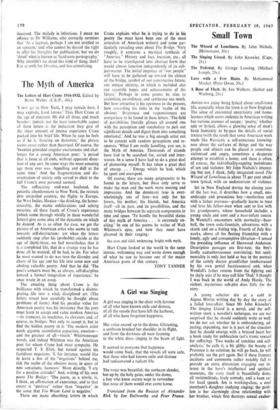The Myth of America
The Letters of Hart Crane 1916-1932. Edited by Brom Weber. (C.U.P., 40s.) 'I MAY go to New York, I may remain here, I may explode, Lord knows.' Thus Hart Crane at the age of nineteen. He did all three, and much besides: indeed, not the least remarkable aspect of these letters is the indication they give of the sheer amount of intense experience Crane packed into his brief life. When he says he feels as if he is 'dancing on dynamite,' the phrase seems exact rather than theatrical. Of course, the 'twenties provided singular excitements and chal- lenges for a young American poet: 'a period that is loose at all ends, without apparent direc- tion of any sort. In some ways the most amazing age there ever was. Appalling and dull at the same time.' And the fragmentation and dis- orientation of society only served to elicit to the full Crane's own personal turmoil.
The suffocating mid-west boyhood, the periodic abandonment to New York, the retreats into unspoiled country, the flights to Europe, the West Indies, Mexico—the drinking, the homo- sexuality, the manic exhilaration and aching miseries; all these facets of Crane's experience (which come through vividly in these wonderful letters) give some idea of the dynamite on which he danced. As is so often the case, we get the picture of an American artist who seems to rush towards self-destruction: yet when the letters suddenly stop after his (probable) suicide at the age of thirty-three, we feel nevertheless that it is a completed life, that in a strange way he has done all he wanted, all he had, to do. For what he most wanted to do was turn the disorder and chaos of his age and his life into some new and abiding valuable poetry. And that he did. 'The poet's concern must be, as always, self-discipline toward a formal integration of experience,' he once wrote in an essay.
The amazing thing about Crane is the brilliance with which he transformed a disinte- grating life into a vital, disciplined art. (The letters reveal how carefully he thought about problems of form.) And his peculiar value for American poetry was his insistence that the poet must learn to accept and value modern America —its tramcars, its machines, its elevators and, of course, its bridges. Not only to accept it, but to find the hidden poetry in it. 'The modern artist needs gigantic assimilative capacities, emotion— and the greatest of all—vision.' Whitmanesque words, and indeed Whitman was the American poet for whom Crane had most sympathy. He respected T. S. Eliot, but turned against his fastidious negations. 'I, for instance, would like to leave a few of his "negations" behind me, risk the realm of the obvious more, in quest of new sensations, humeurs.' More directly, 'I cry for a positive attitude!' And, writing of his own poem The Bridge: 'The poem, as a whole, is, I think, an affirmation of experience, and to that extent is "positive" rather than "negative" in the sense that The Waste Land is negative.'
There are many absorbing letters in which Crane explains what he is trying to do in his poetry (he must have been one of the most articulate of American writers) and some par- ticularly revealing ones about The Bridge. 'Very roughly, it concerns a mystical synthesis of "America." History and fact, location, etc., all have to be transfigured into abstract form that would almost function independently of its sub- ject-matter. The initial impulses of "our people" will have to be gathered up toward the climax of the bridge, symbol of our constructive future, our unique identity, in which is included also our scientific hopes and achievements of the future.' Perhaps in some poems he tries to assimilate, co-ordinate, and synthesise too much. But how attractive is his openness to the present, how rewarding his risks in the 'realm of the obvious.' Brightness and responsiveness are everywhere to be found in these letters. 'The field of possibilities literally glitters all around one with the perception and vocabulary to pick out significant details and digest them into something emotional.' And he was a big enough artist not to be content with random perceptions and re- sponses. 'What I am really handling, you see, is the Myth of America. Thousands of strands have had to be searched for, sorted and inter- woven. In a sense I have had to do a great deal of pioneering myself. It has taken a great deal of energy. . . .' Energy which be had, which he spent and overspent.
Of course, there are many poignancies to be found in the letters, but these only serve to make the man and the work more moving and impressive. And the dominant tone is over- whelmingly one of love—not only for his lovers, his mother, his friends, but America itself—all its past, and its possibilities, and the many bridges between its separate components in time and space. 'To handle the beautiful skCins of this myth of America . . . is extremely ex- citing.' In one of his poems he writes of Walt Whitman's eyes, and how they must have gleamed in their ranging: Sea eyes and tidal, undenying, bright with myth.
Hart Crane looked at the world in the same intense, welcoming way and wrote down enough of what he saw to become one of the major American poets of this century.
TONY TANNER


































 Previous page
Previous page